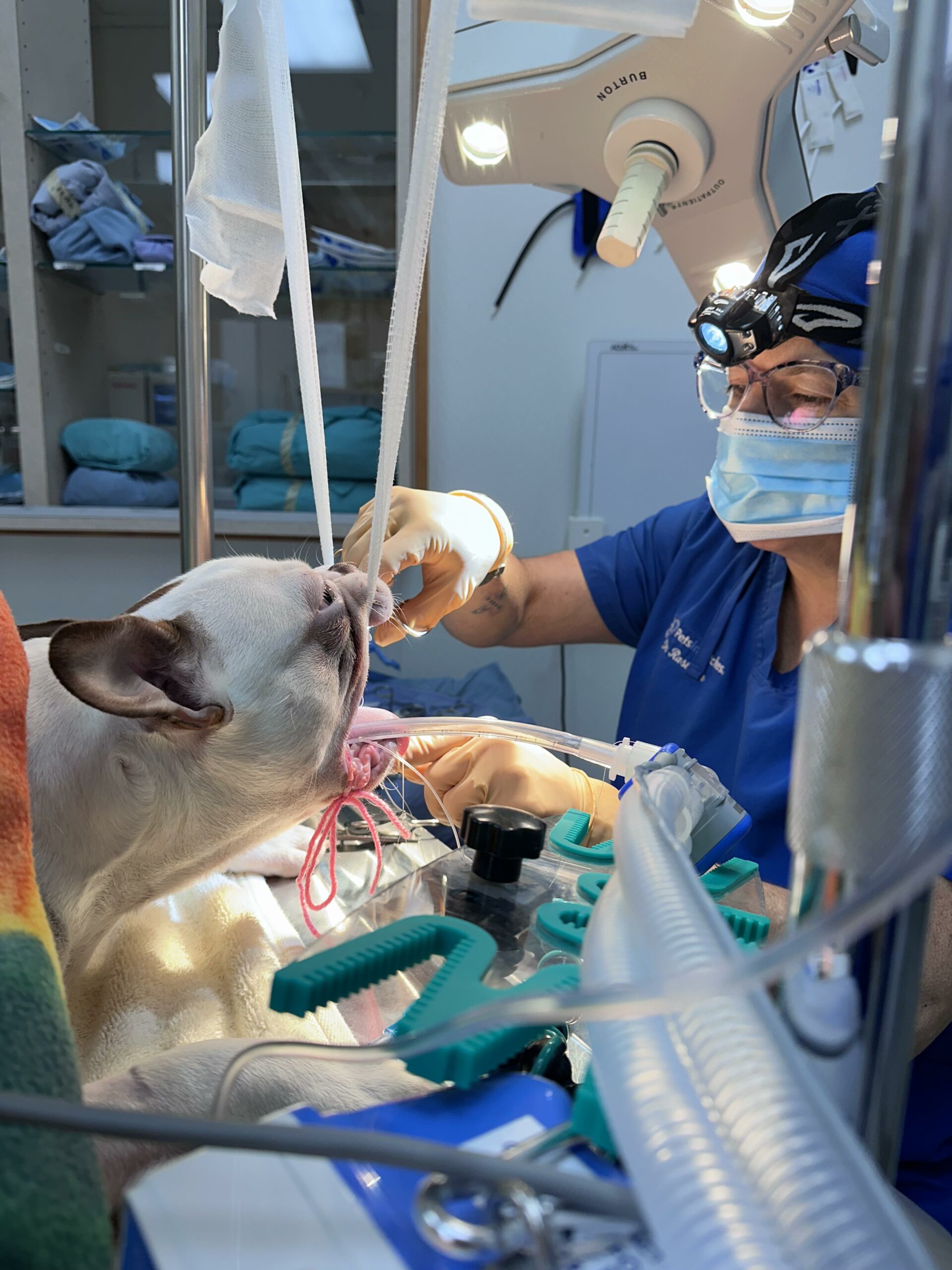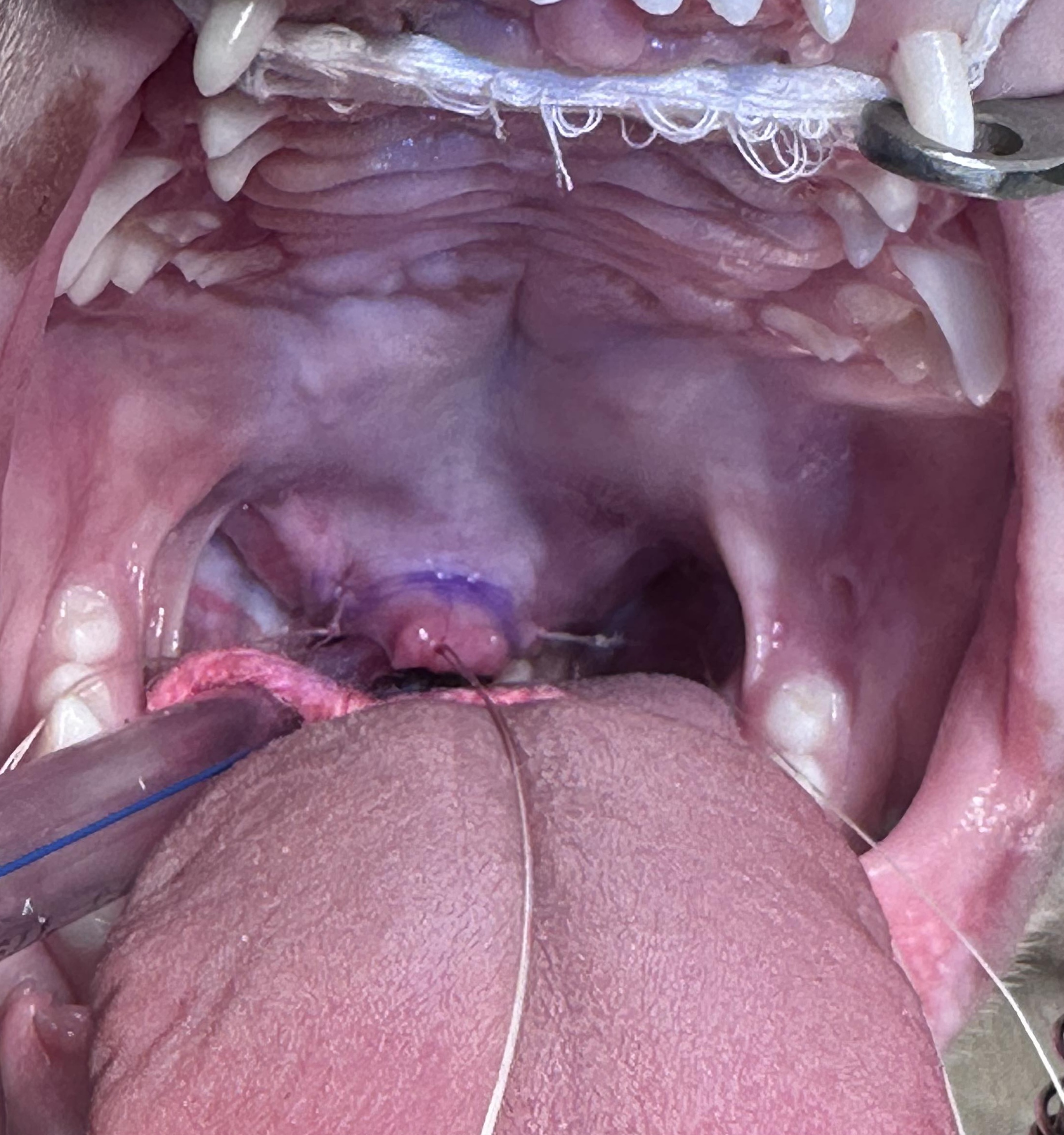

We may love their adorably smooshed faces and endearing wrinkles, but brachycephalic dogs are more susceptible than other breeds to certain respiratory conditions that can affect their breathing, comfort, and overall quality of life. At Pets In Stitches, we now offer several surgeries that can alleviate respiratory issues caused by brachycephaly. Read on to learn more about brachycephalic breeds, what causes their breathing problems, and what can be done to address them.
What Are Brachycephalic Dog Breeds?
The word “brachycephalic” describes the shape of certain dog breeds’ skulls, which are broader and shorter than other breeds’. Pugs, French bulldogs, Boston terriers, and Shih Tzus are all considered brachycephalic dogs. If you’ve ever heard people mention “smooshed-face” or “flat-faced” dogs, they’re probably referring to a brachycephalic breed.
Unfortunately, their distinctive features can lead to health concerns, especially problems with breathing. Brachycephalic dogs can develop Brachycephalic Obstructive Airway Syndrome (BOAS), a condition that describes a specific group of upper airway abnormalities such as stenotic nares, an elongated soft palate, and everted laryngeal saccules, among others. Brachycephalic dogs can have one or more of these specific conditions.
3 Common Brachycephalic Dog Health Issues
For dogs with BOAS or respiratory issues related to brachycephaly, surgery is often recommended. At Pets In Stitches, we now offer several respiratory surgeries that address three common issues for brachycephalic dogs.
Stenotic Nares
What it is: “Nares” is another word for “nostrils,” and “stenotic” means the abnormal narrowing of a passage in the body. In other words, stenotic nares are nostrils that are too small. You may notice your pup isn’t as eager to exercise, their breathing is high-pitched, wheezing, or noisy, they often breathe through their mouths, or they appear restless.
Treatment: A stenotic nares wedge resection can successfully address stenotic nares by removing a wedge of cartilage from the nostril and widening the airway.
Elongated Soft Palate
What it is: Dogs with this issue have a soft palate (the soft tissue part of the roof of the mouth) that is too long for their mouth. The extra tissue can partially obstruct the entrance to the trachea. You may notice that your dog has difficulty breathing (especially when inhaling), is a habitual snorer, or occasionally gags when swallowing.
Treatment: During a soft palate resection, the excess tissue that is partially blocking the trachea is removed.

Beamer, a 9-month-old Boston terrier, came to Pets In Stitches for corrective surgery for an elongated soft palate.

Before surgery, a preoperative mark is made (the blue-purple line in this image). Beyond that mark is 8mm of excess tissue that was contributing to Beamer’s noisy breathing and could cause long-term issues with his airway.
Everted Laryngeal Saccules
What it is: Every dog has laryngeal saccules, which are small pouches located just inside the larynx. If a dog has stenotic nares or an elongated soft palate, these saccules can become everted, or turn outwards, because of the airway pressure caused by increased respiratory effort. The laryngeal saccules can even be pulled into the trachea and can block airflow. You may notice heavy or “wet” breathing, especially if your dog is excited or exercising. Your dog may also be prone to overheating, gagging, or vomiting.
Treatment: When laryngeal saccules become everted, they are removed surgically to address respiratory issues.
When Should You Seek a Consultation for Your Brachycephalic Dog?
Many brachycephalic dogs are born with airway abnormalities that can worsen over time. If you’re noticing that your dog breathes noisily, tires out quickly, or snores a lot, consider getting a consultation.
Think of your dog’s airway like a straw. Drinking soda through that straw is easy—the liquid flows through smoothly and without obstruction. Now think of using that same straw to drink a milkshake. Not so easy, right? Drinking a milkshake through a straw (vs. a soda) is comparable to having an airway abnormality, and the straw is the airway. Left unaddressed, the straw (aka the dog’s airway) can weaken or collapse from the negative pressure, causing additional problems. Corrective surgery early in life—like the treatment Beamer the Boston terrier received—can reduce the risk of those long-term problems.
If you have questions about brachycephalic respiratory conditions or would like to schedule a consultation for your pup, our team at Pets In Stitches is ready to assist. We’re dedicated to providing quality care to every canine patient—and answering your questions to help put your mind at ease. Give us a call today to learn more about the respiratory treatment services we offer.